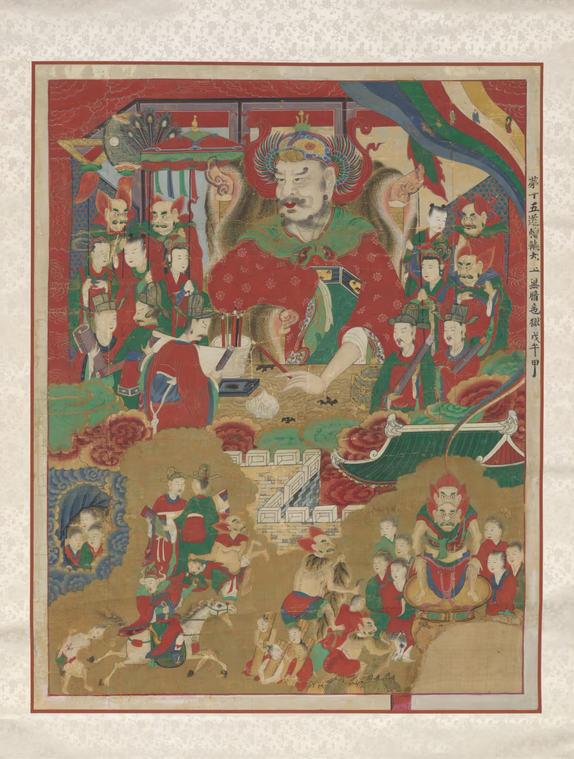The Metropolitan Museum of Art returns Buddhist Painting to Sinheungsa Temple in Korea

The Metropolitan Museum of Art announced today that it is returning a Buddhist painting, titled The Tenth King of Hell (1798), to the Sinheungsa Temple in Sokcho, Gangwon Province, Korea.
The work is believed to have been taken while the Temple was under the control of the United States Army during the Korean War. Through cooperation with, the Sokcho Committee for the Return of Cultural Heritage, and the Sinheungsa Temple of the Jogye Order of Korean Buddhism, the Museum is restoring the work to the Temple.
The return was marked by a ceremony in Seoul, Korea, today with: Max Hollein, Director and CEO of The Met; Heo Min, Administrator of Korea Heritage Service; Kwak Chang-yong, Secretary-General of the Overseas Korean Cultural Heritage Foundation; Lee Byung-seon, Mayor of the City of Sokcho; Lee Sang-rae, Chairman of the Sokcho Committee for the Return of Cultural Heritage; and Chief Monk Ji-hye of Sinheungsa Temple.
“We are honored to partner with the Sokcho Committee for the Return of Cultural Heritage and Sinheungsa Temple on the return of this important work of art,” said Max Hollein, The Met’s Director and CEO. “The Met has a long history of working with colleagues and institutions in Korea, and we look forward to continuing our collaborative efforts to enhance the world's understanding and appreciation of the arts of Korea."
Heo Min, Administrator of the Korea Heritage Service, stated, “The KHS and the Foundation have strengthened the foundation for cultural heritage repatriation and international cooperation through support for civic organizations. This case is an excellent example of close collaboration between the public and private sectors leading to meaningful results.”
Lee Sang-rae, Chairman of the Committee, remarked, “We are delighted that the Tenth King of Hell has returned to its original home. Our cultural heritage holds its greatest meaning when it is in its rightful place. We will continue our efforts to ensure that the remaining three Ten Kings of the Underworld paintings still abroad can also return home.”
The Tenth King of Hell (1798) was purchased by the Museum in 2007. The work is believed to have been originally housed in the Sinheung Temple (Sinheungsa) in Sokcho, Gangwon Province, in South Korea. At The Met, the work was exhibited as part of the Museum’s Korean Art (2012) and Arts of Korea (2008) exhibitions.
The return is the result of a collaborative investigation between the Museum and representatives from the Temple and the Sokcho Committee for the Return of Cultural Heritage who visited the Museum several times to work with the Museum’s curators and researchers regarding the work’s provenance. In 2025, the Museum and Temple representatives agreed the painting should be returned to the Temple.
In the Buddhist world, the Ten Kings of Hell serve as judges of the deceased to determine their fate, including the type and severity of punishment and the course of their cycle of rebirth. This painting depicts the Tenth King in the standard guise of a warrior, and originally formed part of a set of ten scrolls (six of which were formerly in collection of the Los Angeles County Museum of Art and now at Sinheungsa Temple). Seated prominently in the center, the king is surrounded by a retinue of attendants and significant figures of the underworld, including messengers, judges, and wardens. At the top right corner, tiny figures float on a rainbowlike stream (a symbol of the six paths of rebirth) emanating from a double-headed beastly figure (representing the Evil Spirit) at the lower right. The dead, receiving punishments for their transgressions, populate the lower half of the painting.
The inscription written in Hanja characters at the top right—第十五道轉輪大王黑暗地獄戊午甲 (Hangeul: 제십오도전륜대왕흑암지옥무오갑)—may be translated as “The Tenth Great King of the Five Ways and the Right Law, in the darkest hell, painted in the cyclical year muo,” a date that corresponds to 1798.
Main Image: The Tenth King of Hell (1798), Joseon dynasty (1392–1910), Korea. Hanging scroll; ink and color on silk.
